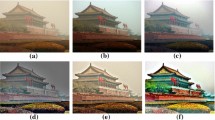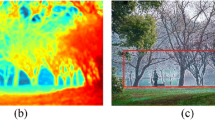Abstract
Images obtained in hazy environments present the phenomenon of low contrast, low saturation, and hue offset. Therefore, the main requirements for a dehazing system are accurate color restoration effects and high visual range. In this paper, an improved atmospheric scattering model based on elliptic curve is proposed to remove haze from a single image. Traditional atmospheric scattering model is improved in the following two aspects. Because of uneven illumination in hazy environment, scene incident light is improved by localized operation to replace the global atmospheric light. Considering multiple scattering effects of reflected light, the scene albedo is refined into two parts, the direct transmission item and the indirect transmission item. An elliptic curve model is established to adaptively estimate weights of the two terms. Thus, the reflected light under different conditions of depth and fog density is finely described. Experimental results show that our method achieves good visual performance. Compared with current methods, the indicator of image visibility and visual contrast increased by 40% and 86.6% on average.











Similar content being viewed by others
References
Narasimhan, S.G., Nayar, S.K.: ‘Interactive (de) weathering of an image using physical models. Proc. IEEE Workshop Colour Photom Methods Comput Vis. 6, 1–8 (2003)
Lu, X., Lv, G., Lei, T.: Single image dehazing based on multiple scattering model. In: IEEE International Conference on Signal Processing, Communications and Computing (ICSPCC), Guilin, China, pp. 239–244 (2014)
Schechner, Y.Y., Narasimhan, S.G., Nayar, S.K.: Instant dehazing of images using polarization. In: Proceedings of the IEEE Computer Society Conference on Computer Vision and Pattern Recognition, Kauai, HI, USA, pp. 325–332 (2001)
Shwartz, S., Namer, E., Schechner, Y.Y.: Blind haze separation. In: IEEE Computer Society Conference on Computer Vision and Pattern Recognition, NewYork, NY, USA, pp. 1984–1991 (2006)
Narasimhan, S.G., Nayar, S.K.: Chromatic framework for vision in bad weather. In: IEEE Computer Society Conference on Computer Vision and Pattern Recognition, Hilton Head, SC, USA, pp. 598–605 (2000)
Narasimhan, S.G., Nayar, S.K.: Contrast restoration of weather degraded images. IEEE Trans. Pattern Anal. Mach. Intell. 25, 713–724 (2003)
Chen, G., Wang, T., Zhou, H.: A novel physics-based method for restoration of foggy day images. J. Image Graph. 5, 888–893 (2008)
He, K., Sun, J., Tang, X.: Single image haze removal using dark channel prior. IEEE Trans. Pattern Anal. Mach. Intell. 33(12), 2341–2353 (2011)
He, K., Sun, J., Tang, X.: Guided image filtering. IEEE Trans. Pattern Anal. Mach. Intell. 35(6), 1397–1409 (2013)
Gibson, K., Vo, D., Nguyen, T.: An investigation of dehazing effects on image and video coding. IEEE Trans. Image Process. 21(2), 662–673 (2012)
Yu, T., Riaz, I., Piao, J., et al.: Real-time single image dehazing using blockto-pixel interpolation and adaptive dark channel prior. IET Image Process 9(9), 725–734 (2015)
Liu, X., Zhang, H., Tang, Y.Y., et al.: Scene-adaptive single image dehazing via opening dark channel model. IET Image Process 10(11), 877–884 (2016)
Xiao, J., Zhu, L., Zhang, Y., et al.: Scene-aware image dehazing based on sky-segmented dark channel prior. IET Image Process 11(12), 1163–1171 (2017)
Salazar-Colores, S., Cabal-Yepez, E., Ramos-Arreguin, J.M., et al.: A fast image dehazing algorithm using morphological reconstruction. IEEE Trans. Image Process. 28(5), 2357–2366 (2018)
Meng, G.F., Wang, Y., Duan, J.Y.: ‘Efficient image dehazing with boundary constraint and contextual regularization’. In: The IEEE International Conference on Computer Vision (ICCV), pp. 617–624 (2013)
Fattal, R.: Dehazing using color-lines. ACM Trans. Graph. (TOG) 34(1), 13 (2014)
Zhu, Q., Mai, J., Shao, L.: A fast single image haze removal algorithm using color attenuation prior. IEEE Trans. Image Process. 24(11), 3522–3533 (2015)
Jun, W.L., Rong, Z.: Image defogging algorithm of single colour image based on wavelet transform and histogram equalization. Appl. Math. Sci 7(79), 3913–3921 (2013)
Seow, M.J., Asari, V.K.: Ratio rule and homomorphic filter for enhancement of digital colour image. Neurocomputing 69(7–9), 954–958 (2006)
Tan, R.T.: Visibility in bad weather from a single image. In: Proceedings of the IEEE International Conference on Computer Vision and Pattern Recognition, Anchorage, Alaska, USA, 2008, pp. 1–8
Land, E.H., McCann, J.: Lightness and retinex theory. J. Opt. Soc. Am 61(1), 1–11 (1971)
Cai, B., Xu, X., Jia, K., Qing, C., Tao, D.: Dehazenet: An end-to-end system for single image haze removal. IEEE Trans. Image Process. 25(11), 5187–5198 (2016)
Ren, W., Liu, S., Zhang, H., Pan, J., Cao, X., Yang, M.H.: Single image dehazing via multi-scale convolutional neural networks. In: European Conference on Computer Vision, Springer, pp. 154–169 (2016)
Bi, G., Ren, J., Fu, T., et al.: Image dehazing based on accurate estimation of transmission in the atmospheric scattering model. IEEE Photonics J. 9(4), 1–18 (2017)
Kim, J.H., Jang, W.D., Sim, J.Y., et al.: Optimized contrast enhancement for real-time image and video dehazing. J. Vis. Commun. Image Represent. 24(3), 410–425 (2013)
Ancuti, C., Ancuti, C.O., Vleeschouwer, C.D.: D-HAZY: a dataset to evaluate quantitatively dehazing algorithms. In: IEEE International Conference on Image Processing, pp. 2226–2230 (2016)
Hautiere, N., Tarel, J.P., Aubert, D., et al.: Blind contrast enhancement assessment by gradient ratioing at visible edges. Image Anal. Stereol. 27(2), 87–95 (2011)
Yu, X., Xiao, C., Deng, M., et al.: A classification algorithm to distinguish image as haze or non-haze. In: Proceedings of IEEE International Conference Image Graph, pp. 286–289 (2011)
Rahman, Z., Woodell, G.A., Jobson, D.J.: A comparison of the multiscale retinex with other image enhancement techniques. In: Proceedings of IS&T 50th Anniversary Conference, pp. 1–6 (1997)
Wang, Z., Bovik, A.C., Sheikh, H.R., et al.: Image quality assessment: from error visibility to structural similarity. IEEE Trans. Image Process. 13(4), 600–612 (2004)
Author information
Authors and Affiliations
Corresponding author
Additional information
Publisher's Note
Springer Nature remains neutral with regard to jurisdictional claims in published maps and institutional affiliations.
Rights and permissions
About this article
Cite this article
Yang, Y., Liu, C. Single image dehazing using elliptic curve scattering model. SIViP 15, 1443–1451 (2021). https://doi.org/10.1007/s11760-021-01876-8
Received:
Revised:
Accepted:
Published:
Issue Date:
DOI: https://doi.org/10.1007/s11760-021-01876-8




